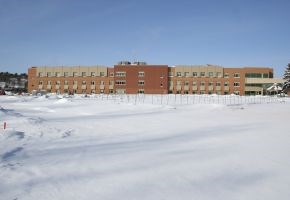Posted by Sudbury Northern Life Reporter Bill Bradley
Greater Sudbury has settled with its insurance company over the fire damage at Pioneer Manor in October 2006.
 City council was briefed Wednesday night on the lengthy
insurance claim process staff were involved with.
City council was briefed Wednesday night on the lengthy
insurance claim process staff were involved with.
The fire destroyed the Boreal Wing that had been built in the 1950, and damaged another section of the building, dating from 1988.
The process was only settled by an arbitrator Dec. 4. The city was awarded $6.1 million for the building loss, $1.7 million above the offer by the insurer and $810,000 for extra costs for operating a second site at Sudbury Regional Hospital for the displaced residents, $206,000 above the insurer's offer.
Tenders have already been awarded for the construction of a new $14.6 million 64 bed wing at Pioneer Manor, designed for the special needs of dementia patients.
Because $7.3 million in funding was received from the province from an infrastructure fund, MIII, and $1.2 million from Pioneer Manor reserve funds, no extra cost to the taxpayer is expected, said city staff.
The reserve fund allocation could be further reduced to $700,000 pending approval of a grant application. Occupancy is expected by June 2010.
But there have been delays.
Council was told by city staff and by Louis Bélanger of Yellowega Bélanger Architecture that the delay in settling the claim was caused by a dispute over the extent of the damage to the foundation and the cost of reconstruction.
Bélanger said that the Boreal Wing of Pioneer Manor was completely destroyed by fire. But in controlling and extinguishing the fire, a great deal of water was used by the fire department.
"Because of the time of year, the fall, when the ground was saturated, water went into and under other sections. This caused the granular base to be taken away and resulted in some floors dropping down," said Bélanger, whose company was asked to assess the damage.
He noted that though damage was suspected under the foundation slab, there was no way to really know for sure.
"We could not see the hidden damage because the building was still standing. We also were concerned about mould problems."
Bélanger said there was a test of the foundation at one spot
that indicated the damage could be widespread elsewhere.
"Our view was that the slab needed remediation."
However, after securing its own experts, the insurer, Frank Cowan Company, disagreed with the extent of the damage to the slab and the amount of remediation required, challenging in April 2007 the $225 cost per square foot of construction, put forth by the city.
Another concern by Bélanger was that the sections destroyed and damaged, if rebuilt in the same manner, were not up new standards expected to be made mandatory in the near future by the province.
Both Pioneer Manor sections lacked private rooms, wheelchair accessible washrooms and general amenities for resident comfort and safety. Meeting those standards in the future would cause the residents to be displaced again and could be a problem since the housing at the hospital was a one-time opportunity only.
"The doors to the rooms were too small to be able to evacuate a bed bound resident. They were 36 inches in width and not the 44 inches that would be required to receive an A standard from the province. They would have to turn the bed sideways and strap the resident to get it out in during an emergency," said Bélanger.
This meant the home was classified as B and C by the province in terms of resident care.
Though the insurer confirmed the A standard necessity was covered by the insurance policy in March 2007, in October 2007 the insurer said that the A standard could be accomplished without making the building bigger, a contention that Bélanger said was impossible.
This affected what the cost of construction would be. The insurer insisted the cost would be $5.5 million, then revised it upwards to $5.6 million.
In November 2007, Trow Associates was engaged by the city to confirm the status of the slab in compliance with Ontario building codes and the A standard of the province. They found the cost to be $2.5 million higher than what the insurer was prepared to offer and that the slab was compromised.
In March 2008 both the city and insurer agreed to arbitration.
Mayor Rodriguez said arbitration was cheaper and quicker than resorting to the courts.
Throughout the reports by staff and by Bélanger, city councilors thanked then for their due diligence in pursing the claim.
"While we regret the length of time required to reach the settlement, our community will greatly benefit from a state-of-the-art facility that will be among the best in Canada," said Rodriguez.
